el es frida kahlo will be on view at the Bruno David Gallery in St. Louis, MO from 1/22-3/6. In conjunction with the exhibition, I am offering a FREE embeddable animated el es frida kahlo gif on mayaescobar.com.

el es frida kahlo will be on view at the Bruno David Gallery in St. Louis, MO from 1/22-3/6. In conjunction with the exhibition, I am offering a FREE embeddable animated el es frida kahlo gif on mayaescobar.com.

Here are some behind the scenes images from the many Acciones Plásticas プリクラ photo shoots.
The Latina Hipster
The Homegirl
The Homegirl putting on fake nails (lovin' the shabbos candlesticks and theory books in the background)
The Avodah Girl
The 612er
---------------------------------------------------------
Check out this inspiring write-up on Acciones Plásticas プリクラ on Truth and Healing Project.excerpt below:
goodness. I’ve been thinking a lot about the intersections between new media and traditional forms of knowledge and how these intersections can be ways of supporting tradition, innovation, resistance and liberation. As a media-maker, I’ve thought a lot about non-traditional forms of telling stories and the value of stories to allow us as individuals and communities to grow and remain in movement. I want to both honor our traditions and create space for challenge in order to support growth. This is particularly challenging when, as indigenos, we are usually FORCED into the frozen stance (as my sister Whisper says) of the “American Imaginary”. Born out of a flat analysis, the “American Imaginary” boxes us into specific archetypes and narratives that, though perhaps grounded in truth, metaphorically and at times literally “freeze” us and immobilize us from engaging in healthy movement and LIFE. As a guatemalan-born/ mixed -id’d/ mayan-adoptee I’ve dreamed about new and innovative ways to create forums and craft form that embodies the intersections of say, mayan id, transracial queer, working class, single teen mama id. For example, as a queerasfuck femme I’ve LITERALLY dreamed of beginning a series of corsets created out of huipil’s with stories attached to each… though I have yet to begin work on that. I am so excited by the thoughts of spaces for dialogue, beauty, challenge & examination of the COMPLEX identities embodies by the our contemporary indigena communities. . Fierce and phenomenal chicana and radical latina artists have had HUGE impacts on me but I’ve been hungry to see this come from other guatemelan/ mayan artists. Today, I got a taste of a contemporary and GUATEMALAN artist who is actively engaged in a similar examination! I came across this blog (and art work) and it was as if an answer was given to me in the form of possibilities. A sweet affirmation that this form of mayan/guatemalan art CAN and DOES exist.

from obsessed with frida kahlo
[youtube=http://www.youtube.com/watch?v=_RrS5xvfRXg]
no sos frida kahlo, 2007
[youtube=http://www.youtube.com/watch?v=dsHCjxKoYc4]
puppets, 2007

My newest partner in crime is the talented, witty, godzilla and pikapika lovin' Chicano artist and curator Rio Yañez. I first came across his Ghetto Frida two years ago, while working on the project Obsessed With Frida Kahlo. Immediately I felt some sort of cosmic connection-not to Ghetto Frida- but to her creator. And then to make matters worse better, I found out that he is the son of one my biggest heroes- Yolanda Lopez!There was really no option other than collaboration. It was fate.Last month we finally initiated our long distance partnership through a tweet. Since then we have been communicating through TwitPic, Facebook, YouTube, phone calls and texts, and of course mutual shouts in interviews on the blogosphere (mine to Rio & Rio's to me.)Here are a few examples of Rio's recent work:
"I’ve been twittering for about a week now at http://twitter.com/rioyanez. I signed up as a way to contact Amber Rose after she started writing and posting about the portrait I created of her. I have to say, the most exciting aspect of twitter is the way people distribute images. The short urls for twitpics that often pop up on tweets evoke a sense of curiosity in me; more so than the many thumbnails that can be found on facebook. I think the lack of a thumbnail is more alluring and it forces you to chose to see the image or not, there’s no middle ground of a provided preview." (from his blog)
"Artist Curator Rachel-Anne Palacios flanked by Zitlalix and I. I created this portrait to thank Rachel for including me in the recent Frida exhibit she curated and to join the many artists who are on display on the walls of her apartment" (from flickr)
These images represent my first foray into my Raza Zombies series. They were inspired by the single best mainstream comic book of the 21st century: Marvel Zombies. Marvel Zombies re-imagines classic superheroes as flesh eating zombies. After reading it I felt compelled to do some zombie transformations on a few of my own personal heroes. More to come. (from flickr)[youtube=http://www.youtube.com/watch?v=1AhRQrJ7ePg]
Video of Gomez Peña setting the record straight for Rio regarding his Facebook presence.
[youtube=http://www.youtube.com/watch?v=QycIf6uKRd0]
Rio's Ghetto Frida Mural in the Mission District
stay tuned for more...
I was interviewed on the Latino Blog Directory site Blogaderaclick here for full interview:
 [more]check out other Blogadera interviews with Carrie Fergerson and Jo Ann Hernandez
[more]check out other Blogadera interviews with Carrie Fergerson and Jo Ann Hernandez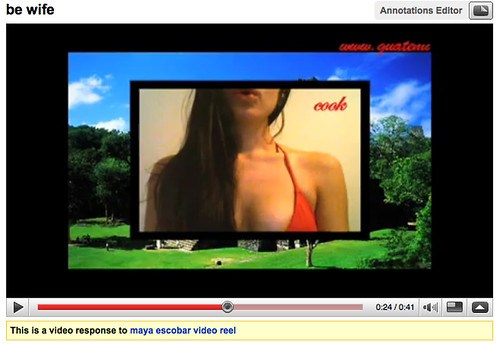
In October of 2006 my rabbi started blogging. While trying to comment on one of his posts, I accidentally registered my own blog. Within hours of posting a comment, my name began appearing in Google searches. I was now linked to the post I had commented on, previous posts my rabbi had written, comments left by other users and the posts they had written elsewhere within the blogosphere. The rapidity with which I was branded, not only by my own online activity, but also by the online activity of others, seemed incomprehensible. I thought about this phenomenon in relationship to, the images that my friends and I had posted on Myspace throughout that year. I unknowingly went from being slightly annoyed and simultaneously amused by the phrase "take a picture of me for my Myspace", to it becoming completely natural and almost organic to document every moment, every outing, every time my friends and I put on make up, and to take pictures for Myspace. I saw this behavior even further exaggerated in the high school students I was student teaching. Their conversations were dominated with events that had transpired on Myspace, and when they were not talking about Myspace they were taking pictures for Myspace.When we talked about the factors that contributed to the construction of their individual and collective identities, my students were quick to bring up their style of dress, group of friends, the neighborhood they lived in, and the way they spoke. Yet not a single student referenced their online activity, the pictures they posted, the groups they joined, the comments they left on each others pages. I wondered why it was, that they were so aware of and adept at reflecting upon their experiences in the material offline world, but failed to mention the social network that played such a major role in their day-to-day lives.DECONSTRUCTING PERSONAL IDENTITY
I thought about this phenomenon in relationship to, the images that my friends and I had posted on Myspace throughout that year. I unknowingly went from being slightly annoyed and simultaneously amused by the phrase "take a picture of me for my Myspace", to it becoming completely natural and almost organic to document every moment, every outing, every time my friends and I put on make up, and to take pictures for Myspace. I saw this behavior even further exaggerated in the high school students I was student teaching. Their conversations were dominated with events that had transpired on Myspace, and when they were not talking about Myspace they were taking pictures for Myspace.When we talked about the factors that contributed to the construction of their individual and collective identities, my students were quick to bring up their style of dress, group of friends, the neighborhood they lived in, and the way they spoke. Yet not a single student referenced their online activity, the pictures they posted, the groups they joined, the comments they left on each others pages. I wondered why it was, that they were so aware of and adept at reflecting upon their experiences in the material offline world, but failed to mention the social network that played such a major role in their day-to-day lives.DECONSTRUCTING PERSONAL IDENTITY (today) I am referring to myself as a performance artist, Internet curator, and editor. I create and (concurrently) perform multiple online identities, by sampling from different representations of existing cultural discourses. I fragment my personal experiences and invite others to join in, and modify and regroup those fragments. By doing this I hope to share the process through which I deconstruct and reconstruct my individual conception of self, so that others can do the same in their lives.In the series Acciones Plásticas I performed representations of five constructed characters: a religious Jewish woman, a spoiled Jewish girl, a ghetto Latina, a sexy Latina professor, and a Mayan woman. I created low quality YouTube video blogs for four of the characters, the Mayan woman did not have a video, as she would not have had access to YouTube technologies. The videos were strategically placed on popular social networking sites, including YouTube and MySpace. The layout of YouTube contextualized the videos and framed them with user comments and similarly tagged user content. Jewish Girls was picked up by a popular left-wing Jewish blogging site Jewschool, and soon entered the Jewish Blogosphere where it was referred to as the JAP. This repositioning shifted the focus from the portrayal of multiple interwoven identities to a depiction of the Jewish American Princess. The JAP became how people knew my work, validating me while simultaneously conflating my identity with that of this particular character.
(today) I am referring to myself as a performance artist, Internet curator, and editor. I create and (concurrently) perform multiple online identities, by sampling from different representations of existing cultural discourses. I fragment my personal experiences and invite others to join in, and modify and regroup those fragments. By doing this I hope to share the process through which I deconstruct and reconstruct my individual conception of self, so that others can do the same in their lives.In the series Acciones Plásticas I performed representations of five constructed characters: a religious Jewish woman, a spoiled Jewish girl, a ghetto Latina, a sexy Latina professor, and a Mayan woman. I created low quality YouTube video blogs for four of the characters, the Mayan woman did not have a video, as she would not have had access to YouTube technologies. The videos were strategically placed on popular social networking sites, including YouTube and MySpace. The layout of YouTube contextualized the videos and framed them with user comments and similarly tagged user content. Jewish Girls was picked up by a popular left-wing Jewish blogging site Jewschool, and soon entered the Jewish Blogosphere where it was referred to as the JAP. This repositioning shifted the focus from the portrayal of multiple interwoven identities to a depiction of the Jewish American Princess. The JAP became how people knew my work, validating me while simultaneously conflating my identity with that of this particular character.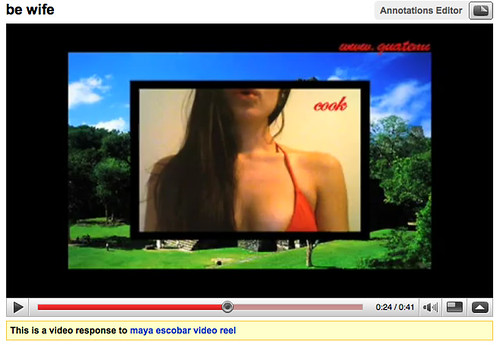 One of the strategies that I employed to counteract idea of "me as The JAP" was to group videos from the series Acciones Plásticas together with three other Youtube videos in a video reel of my work. The first video in the reel, el es frida kahlo is me dressed as Frida Kahlo where I violently scream I am Frida Kahlo! In second video Be Wife, I wear a bright red bikini top in front of an image of a Mayan temple in Tikal. Traditional Guatemalan marimba music plays in the background, while red text scrolls across the top reading Guatemala's finest export. The third video Que Sencilla, features me as a little girl, who is being coaxed by an off-camera male voice to perform a dance for the camera.Someone who is expecting to see a Jewish American Princess, is instead greeted with an enraged
One of the strategies that I employed to counteract idea of "me as The JAP" was to group videos from the series Acciones Plásticas together with three other Youtube videos in a video reel of my work. The first video in the reel, el es frida kahlo is me dressed as Frida Kahlo where I violently scream I am Frida Kahlo! In second video Be Wife, I wear a bright red bikini top in front of an image of a Mayan temple in Tikal. Traditional Guatemalan marimba music plays in the background, while red text scrolls across the top reading Guatemala's finest export. The third video Que Sencilla, features me as a little girl, who is being coaxed by an off-camera male voice to perform a dance for the camera.Someone who is expecting to see a Jewish American Princess, is instead greeted with an enraged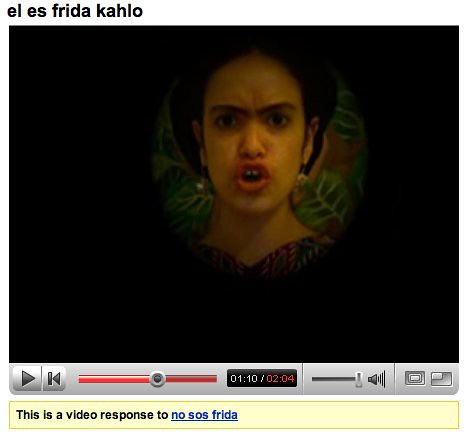 Latina artist, trying to fight the stigma of being associated with Frida Kahlo. My inclusion of these additional videos was to show the multidimensionality of the five characters initially presented in Acciones Plásticas. The Mayan women does not have her own YouTube video, but with the addition of the Be Wife video, her absence is felt even greater. The face of Guatemala in these videos, is the chest of a mail order bride. Another example can be seen within the four original videos themselves. With the grouping of the ghetto latina with the sexy latina professor, vast cultural and class difference can be seen between the two representations of Latina women. Put together with el es frida kahlo and Be Wife, there are suddenly five Latina performers all acting on one stage.
Latina artist, trying to fight the stigma of being associated with Frida Kahlo. My inclusion of these additional videos was to show the multidimensionality of the five characters initially presented in Acciones Plásticas. The Mayan women does not have her own YouTube video, but with the addition of the Be Wife video, her absence is felt even greater. The face of Guatemala in these videos, is the chest of a mail order bride. Another example can be seen within the four original videos themselves. With the grouping of the ghetto latina with the sexy latina professor, vast cultural and class difference can be seen between the two representations of Latina women. Put together with el es frida kahlo and Be Wife, there are suddenly five Latina performers all acting on one stage.
Jewish Girls from the series Acciones Plásticas
[youtube=http://www.youtube.com/watch?v=GBjBN0ftcP0]Responses to Jewish Girls
[youtube=http://www.youtube.com/watch?v=PQphBV2Q0ZE]

Por David Sperber en Ma’arav Israeli Arts and Culture MagazineTraducción de Gonzalo Escobar (de Traducción de Shlomit Nehorai)Maya Escobar es sin ninguna duda una de las personas más de moda en el desarrollo del arte judío-estadounidense. Escobar se define como “artista disléxica del Internet”. Y para ver su trabajo uno no necesita ir muy lejos.Su trabajo es creado principalmente en el formato familiar del Internet, y se puede ver más frecuentemente en Youtube. Escobar es hija de madre Judía y de padre Guatemalteco, ella define su trabajo personal y versátil de arte como una investigación antropológica-sociológica dentro de la narrativa que utiliza medios electrónicos contemporáneos.Acciones Plásticas incluye películas de corto metraje que presentan una serie de caracteres persuasivos y monólogos en los que se cuestiona la identidad. En la primera película de corto metraje de la serie aparece, vestida como la artista mexicana Frida Kahlo quien se convirtió en un ícono dentro del discurso feminista. Se argumenta comúnmente que Kahlo tenía algunas raíces judías. Escobar aparece vestida como Kahlo con sus famosas cejas mientras que grita “Yo soy Frida Kahlo. Usted es Frida Kahlo. Nosotros somos Frida Kahlo”. En agitación o en éxtasis se desgarra su ropa, se despeina, se quita el maquillaje y vuelve a ser ella misma.[youtube=http://www.youtube.com/watch?v=xlMPoFXRT18]
En la otra película de corto metraje de la serie, ella continúa con un monólogo de una mujer ortodoxa judía. El texto aquí es tan exacto que por un minuto la línea entre la ironía y la comedia burda y la seriedad profunda es borrosa.[youtube=http://www.youtube.com/watch?v=8H8mpau6dSc]En otra película de corto metraje se presenta el estereotipo de mujer latina como objeto sensual sexual, cuando aquí el tema se desenvuelve también entre la aprobación y la destrucción de los estereotipos. Escobar presenta diversos episodios basados en la realidad que ella misma ha experimentado enfocados en su identidad híbrida como mujer, como judía y como latinoamericana.[youtube=http://www.youtube.com/watch?v=F_1X1igrL4U]Otro trabajo de Escobar es My Shtreimel (Mi sombrero de peluche judío de Europa Oriental) - un vídeo-blog que también se puede encontrar en Youtube. En esta sección aparece un joven de más de veinte años que está sentado frente a una computadora y habla de sus rituales del Shabbat (el día de descanso para los judíos). El monólogo describe un mundo judío amorfo en el cual la esencia judía viva y material no es obligatoria a sus instituciones, sobre todo en el marco personal. Una parte central en este mundo es la auto depreciación de uno mismo: El joven muestra su querido shtreimel y menciona que el shtreimel que se ve como el sombrero tradicional es realmente un sombrero de mujer comprado en una tienda de segunda.
En el trabajo “eruv”* (entremezclarse) Escobar relata el hecho que en Berlín no hay ningún eruv aun cuando allí existe una comunidad judía vibrante. En una serie de entrevistas fotografiadas con los habitantes de la ciudad ella transforma la noción del eruv - en una noción legal halajá (recopilación de las principales leyes judías) que crea una transformación del espacio público en el espacio privado, en una mezcla - la creación múltiple de caracteres y de mundos. El eruv se transforma en un concepto cultural que celebra lo diferente y lo único. Los individuos crean un mosaico espléndido que ensambla un grupo “colectivo” diferente como concepto social. La forma en que Escobar trata el tema es típico al mundo judío-estadounidense del arte que tiende a transferir los conceptos del halajá práctico y para transferirlo a otro mundo, y así se transforma en una metáfora de la condición personal o social. La experiencia personal es significativa a Escobar. Como otros rituales judíos, el Shabbat abarca los sentidos prácticos que materializan la condición privada en un espacio privado. Excepto que el entendimiento del espacio privado y del espacio público es fluido y cambia siempre. Yo pienso que es muy importante de que la gente celebre su Shabbat como experiencia agradable, definida y personal. Los rituales del Shabbat evolucionan con el tiempo - no como obligación inamovible que se transfiere de generación en generación, pero como resultado de una opción simple del individuo de crear él/ella las mismas costumbres agradables de Shabbat. Todos tenemos esta clase de costumbres.”El uso intercontinental del Internet dio a luz a una generación de individuos que crean algo solo por el hecho de crear algo, y el concepto del crear arte por el hecho del crear arte consigue de esa manera un nuevo significado. Los medios de comunicación del Internet conectan a individuos y contribuyen mutuamente a entrelazar a la gente que trabaja por separado en lugares lejanos. El trabajo nuevo del Internet desafía las viejas definiciones en lo referente a lo qué se considera arte y a lo que no es. De igual manera, adopta nuevas formas de la presentación que no son la norma en la corriente principal del mundo del arte, y le revigoriza al campo del arte.La discusión del trabajo de Escobar conduce a una discusión más amplia sobre las diferencias entre el pensamiento judío en la conversación israelita en la nueva comprensión de la opinión estadounidense del mundo. El compromiso judío-artístico en los Estados Unidos está influenciado por la introducción de las ideas de la nueva era en el centro de la conversación, y está integrando en el esfuerzo de crear una conexión entre la cultura contemporánea y la identidad judía tradicional. Dentro de la comunidad estadounidense-judía hay muestras de un movimiento de una expresión judía institucional organizada en una expresión única y personal de experiencias muy personales. Estos artistas que reorganizan las tradiciones en sus propios términos, y de esta manera contribuye no insignificantemente a la definición Ortodoxo-Moderno No-Ortodoxo Judío-Estadounidense nuevamente. El acoplamiento entre la cultura judía y la identidad judía al arte ocupa un papel central en esta conversación.Los ecos de esta tendencia se pueden encontrar también en Israel (por ejemplo, en la cultura joven de Yiddish {idioma hablado por los judíos de Europa Oriental} en Tel Aviv), pero generalmente todavía hay una desconexión profunda entre los conceptos dominantes en Israel y en los Estados Unidos. En Israel es común la conexión entre el judaísmo con una tradición organizada y con el linaje o la línea de sangre y la consanguinidad basada en una continuidad genética. Por otra parte, muchos judío-estadounidenses jóvenes se casan fuera de su religión, pero sin embargo ellos se ven como parte integral del mundo judío y saben que no serán expulsados por esto. En comparación con los israelíes que experimentan su identidad judía en términos de desintegración que siguió la restauración, los judío-estadounidenses crean nuevas ramas donde las metáforas del crecimiento y del renacimiento se acoplan mejor.La unión de la cultura y del arte contemporáneos a la creatividad judía se expresa en características de moda como tatuajes, música hip-hop, arte del Internet y otras formas similares, y se entiende a menudo como la desconexión con la dicotomía dualista aceptada entre lo sagrado y lo mundano. Esto es porqué los tradicionalistas consideran estas formas de arte como provocación peligrosa. La interconexión cultural de estos nuevos conceptos durante discusiones desafiantes con los viejos conceptos culturales. Filológicamente hablando se puede decir que pedir prestados símbolos a partir de una disciplina a otra interfiere con los sistemas semióticos. En el lenguaje Cabalístico (kabbalah o cábala es una de las principales corrientes de la mística judía) se dice que la energía creada durante la fricción producida por la desintegración de las cosas va a crear generalmente “nueva luz”.* De acuerdo a la religión judía durante el Shabbat lo judíos no pueden hacer ningún trabajo, ni tampoco llevar cosas fuera de sus casas o de las murallas de su ciudad. Cuando la ciudad o pueblo no tiene murallas, se tiene que construir un “eruv”, que es una construcción de cables y postes para así poder marcar los límites físicos del pueblo y esto se convierte en una estructura virtual imaginaria.
Last weekend Carianne and I went to NY for the 2008 Whitney Biennial. As we expected from a survey of Contemporary American Art, not everything in the exhibition appealed to us. However neither of us was disappointed because we were not expecting to be unilaterally wowed. Upon leaving the Whitney, we got into an in-depth discussion about individuals' preconceived expectations, and the role they play in the determining interaction/interpretation/enjoyment, with actual works of art. Soon after this conversation, I was put to the test. As any young MFA student (traveling to New York) who has any hopes of some day having a career, Carianne and I were preparing to leave our hotel, to visit the elusive Chelsea Galleries, when I came upon an announcement for a show at El Museo Del Barrio, ARTE ≠ VIDA: ACTIONS BY ARTISTS OF THE AMERICAS
“Arte no es vida” surveys, for the first time ever, the vast array of performative actions created over the last half century by Latino artists in the United States and by artists working in Puerto Rico, the Dominican Republic, Cuba, Mexico, Central and South America.
Many of the works included in Arte ≠ Vida have subtle or overt political contexts and content: military dictatorships, civil wars, disappearances, invasions, brutality, censorship, civil rights struggles, immigration issues, discrimination, and economic woes have troubled the artists’ homelands continuously over the past four decades and therefore have infiltrated their consciousness. According to curator Deborah Cullen, “the exhibition title challenges the commonplace idea that art is equivalent to life, and life is art. What is proposed through these many works is that while art affirms and celebrates life with a regenerative force, and sharpens and provokes our critical senses, artistic actions which address inequalities and conflict are not equivalent to real life endured under actual repression.”
Over 75 artists and collectives are represented in Arte ≠ Vida, including ASCO, Tania Bruguera, CADA, Lygia Clark, Papo Colo, Juan Downey, Rafael Ferrer, Guillermo Gómez-Peña, Alberto Greco, Alfredo Jaar, Tony Labat, Ana Mendieta, Marta Minujin, Raphael Montañez-Ortiz, Hélio Oiticica, Tunga and contemporary practitioners including Francis Alÿs, Coco Fusco, Regina José Galindo, Teresa Margolles and Santiago Sierra. The exhibition is arranged in four major sections, in which each decade is represented by several specific themes that often cross national boundaries. 1960-1970 looks at select precursors, signaling, destructivism and neoconcretismo; 1970-1980 considers political protest, class struggle, happenings, land/body relationships and border crossing; 1980-1990 focuses upon anti-dictatorship protest and dreamscapes; and 1990-2000 references the Quincentenary, multiculturalism, postmodernism and endurance. An additional section highlights interventions that artists have carried out on television over the past 20 years. In these chronological, thematic groupings, viewers will be able to explore the interconnections among various artists’ actions as well as the surges of activities triggered by specific events in certain countries.
I didn't know what to do. This sounded to good to be true, but we also knew we were supposed to visit the Chelsea Galleries. I considered just buying the catalogue to the exhibition and skipping the show. I don't know if it was faith or instinct that got us there, but I can say with out any doubt in my mind that this was single handedly the best exhibition I have ever attended.
"¿Quién puede olvidar las huellas?," Regina Galindo. 2003.
Galindo walking through the streets of downtown Guatemala City, wetting her feet in a blood-filled bucket, and leaving a path of footprints from the Constitutional Court building to the Presidential Palace, where she was welcomed by a police battalion. The Court had just validated former dictator Efraín Ríos Montt, the country’s foremost author of genocide, as a presidential candidate.
[youtube="http://uk.youtube.com/watch?v=D46p71QdCTc"]

Oscar Bony (1941-2002) hired a working-class family at twice their going wage to pose in a Buenos Aires gallery as a living work of art
[youtube=http://uk.youtube.com/watch?v=8N5xbLtokZY]
"Arte Reembolso/Art Rebate" by Elizabeth Sisco, Louis Hock and David Avalos. 1993.


[...] "The current economic recession has been debilitating for many artists regardless of the content of their work. Since this climate is characterized by a particular hostility toward controversial art, it is especially significant that Elizabeth Sisco. Louis Hock. and David Avalos have maintained a reputation for causing trouble in San Diego. Their collaborative public art projects receive scandalous reports in local and national news media and are often used as examples of the National Endowment for the Art' inadequate standards of quality. Their most current collaborative project Art Rebate (1993) refunded $10 bills to 450 undocumented workers along the San Diego, California/Mexico border. It was commissioned by the Museum of Contemporary Art, San Diego and Centro Cultural de la Raza as part of the "La Frontera/The Border" exhibition. In response to recent attention to border relations due to NAFTA and other government policies, the artists wished to refute the popular misconception that undocumented Mexican workers do not pay taxes as well as demonstrate. albeit with a small symbolic gesture, their appreciation of the undocumented as valued members of Western states, communities. Furthermore, I believe their work has significant implications for undocumented workers from other nations, residing in other regions of the United States - Caribbean workers in Florida and New York City, for example. If the communities in which the undocumented workers from these areas work and reside could also acknowledge their common contributions, in the form of taxes among other things, then perhaps we as a society could also begin to address the crimes inflicted upon these groups and apply our democratic notions of human rights to those within our national borders. [...]
"The projects are clearly controversial. That's not an accident. It's not as if someone latches onto the projects and holds them up as problematic. We intend to create something that is provocative and engenders a public discussion. It is public art, not art in the public. The work is defined by its performance in the community. The public discussion is crucial to the project. In order to begin a discussion we initiate an action - for example, a bus poster or a $10 rebate - that starts the ball rolling. We definitely aim to draw in the broadest spectrum of people, including those in power for the discussion. Obviously the media is not a neutral mechanism for communicating the events that unfold during the projects: it has an agenda that shapes its participation in the discussion. For example, much of the language used to describe Art Rebate in the press was the same inflammatory rhetoric promoted and laid out by the politicians who had given a profile of blame to the undocumented. Similarly, the press had a hard time imagining, and therefore was unable to fairly convey, the undocumented as taxpayers. The press was invited to experience the act of rebating these signed $10 bills. They were encouraged to ask the opinion of undocumented workers concerning their status as taxpayers, but the responses failed to appear prominently in the news media. The media coverage was not a means of evaluating the project but rather a component of the project. Their viewpoints describe a conceptual social space in which they situate the taxpayer and the undocumented in different realms."
"The Parthenon of Books/Homage to Democracy, Buenos Aires," Marta Minujín. 1983.
In December 1983 the Argentine Conceptual artist Marta Minujin and a group of helpers spent 17 days building a full-scale model of the Parthenon in a public park in Buenos Aires, Roberta Smith writes. Except for a metal scaffolding, it was made almost entirely of books wrapped in plastic. All the books had been banned by one of the most oppressive juntas in the country’s history, which was just being dismantled after Argentina’s first democratic election in a decade. “The Parthenon of Books/Homage to Democracy,” as Ms. Minujin’s work was titled, stood for about three weeks. Then the public was allowed to disassemble the piece and keep the books.
partenon de libros marta minujinAvenida 9 deJulio y Avenida Santa Fe. Buenos Aires. Argentina. Concebida como un monumento a la democracia y a la educación por el arte, Partenón constaba una estructura metálica, réplica del partenón, recubierta con prohibidos durante la dictadura militar.


[...]In a similar fashion to the live human spectacles of the past, Fusco and Gomez-Peña performed the role of cultural "other" for their museum audiences. While on display the artists' "traditional" daily rituals ranged from sewing voodoo dolls, to lifting weights to watching television to working on laptop computers. During feeding time museum guards passed bananas to the artists and when the couple needed to use the bathroom they were escorted from their cage on leashes. For a small donation, Fusco could be persuaded to dance (to rap music) or both performers would pose for Polaroids. Signs assured the visitors that the Guatinauis "were a jovial and playful race, with a genuine affection for the debris of Western industrialized popular culture . . . Both of the Guatinauis are quite affectionate in the cage, seemingly uninhibited in their physical and sexual habits despite the presence of an audience." Two museum guards from local institutions stood by the cage and supplied the inquisitive visitor with additional (equally fictitious) information about the couple. An encyclopedic-looking map of the Gulf of Mexico, for instance, showed the supposed geographic location of their island. Using maps, guides, and the ambiguous museum jargon, Fusco and Gomez-Peña employed the common vocabulary of the museum world to stage their own display[...]
"Construction of a Traditional Rural Oven,'' Víctor Grippo y Jorge Gamarra. 1972.
CONSTRUCCION DE UN HORNO POPULAR PARA HACER PAN
Intención: Trasladar un objeto conocido en un determinado entorno y por determinada gente, a otro entorno transitado por otro tipo de personas.Objeto: Revalorizar un elemento de uso cotidiano, lo que implica, además del aspecto constructivo escultórico, una actitud.Acción:a) Construcción del Hornob) Fabricación del Panc) Partición del Pan.Resultante pedagógica: Describir el proceso de construcción del Horno y de la fabricación del Pan. Distribuir una hoja. Será posible la participación del público mediante un intercambio de información.
"Untitled (Body Tracks),'' Ana Mendieta. 1974.

Acciones Plásticas was discussed in current issue of Bitch Magazine Lost and Found #38. The article is entitled The Princess Diaries: In an Age of Ostentation the J.A.P. is Back written by Julia Appel, a rabbinical student at Hebrew College.To view the full article (pdf version) click here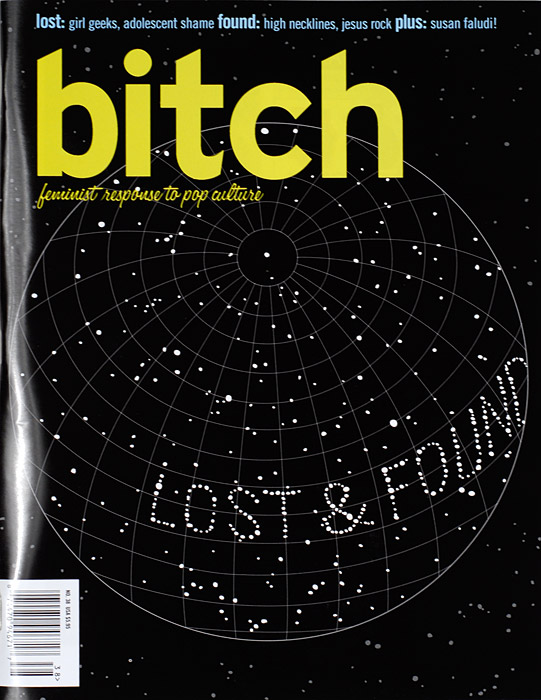
One blogger on Jewschool questioned the artistic success of a new piece by a performance artist named Maya Escobar entitled Acciones Plasticas (Plastic Dolls), in which the artist impersonates in short video segments various stereotypes that make up her identity. Her send-up of the J.A.P. was familiar to me from my years spent in a heavily Jewish, upper-middle-class suburb of Boston. Escobar's J.A.P. flips her straight dark hair and fiddles with her silver jewelry as she talks insipidly about her high-school popularity and rejection of male suitors. The blogger wrote by way of illustration, "She...nails the J.A.P. with a monologue so infuriatingly vapid and unaware it's as excruciating as the real-life experience."

[...]Using the Jewish American Princess in a deadpan manner can result in a sophisticated social critique that reveals how ridiculous the stereotype itself. The key is absurdity: Take Sarah Silverman, who frequently conjures the J.A.P. in her comedy, with mixed results [...] Maya Escobar's piece also falls in this category: by contextualizing the character in her video as a "doll" she reveals how ridiculous it is to take the character seriously. But what about the less-successful attempts at deploying the term? The reason "J.A. P." is ripe for reclamation is because it stands at the border between resonantly hateful and outdated. Although not as widely used as it once was, it still packs a punch. Therefore, if the context is not skillfully executed, the attempt serves not to interrogate or reclaim, but rather only to perpetuate the myth[...]
Below are selected excerpts from a grant proposal that I recently submitted to Washington University, for a cultural identity dialog exchange between Guatemalan Youth living within the diaspora and those living in Guatemala. Please contact me if you are interested in collaborating, participating (either yourself or your child) and funders.
Within most North American contexts I am inevitably the only Guatemalan representative. As a child I yearned for this paternal classification. I wanted desperately to be a Guatemalan. However, upon entering academia I immediately became the Guatemalan. As an artist, this categorization places me in the awkward position of being unable to produce work without feeling and seeming inauthentic, voyeuristic, and exploitative.In order to directly confront these insecurities and consequential perceptions, I will expose myself to the very environment where I feel most uncomfortable: Guatemala. I will present myself exactly as I do in the United States with the self-imposed title: Guatemalan Jewish Interdisciplinary Artist and Educator. Working as a researcher, artist, educator, student, performer and public speaker I will interact with all of the communities represented by the aforementioned title.
[...]In this lesson, students will critically analyze the ways in which Guatemalans have been depicted both historically and presently. They will look at national and international examples of these depictions, produced by: historians, anthropologists, sociologists, the media, and artists. Considering the mediums that have been utilized in these depictions (newspapers, magazines, history books, movies, paintings, the internet, etc.), and their availability to the general public, students will evaluate the impact of these depictions on the formation of their personal identity.Students will then discuss their feelings towards Guatemalan youth living in the US, who have inevitably been equally (in not more so) effected by these depictions. They will then analyze the specific elements these depictions falsely portray or leave unsaid, thus identifying the important things they want Guatemalan youth living in the US to know about their culture. [...]• What role does an individual play in defining their identity?• How is identity affected by: surrounding community, geographic location, socio-economic background, religious beliefs, political affiliation, gender, sexuality, level of education, access to technology?• What responsibilities accompany self-imposed cultural allegiance?• What responsibilities accompany societal-imposed cultural allegiance?
student work from Cuyotenango, Guatemala 
Please Check for updates, as I continue to add more to this post.Dianna Montano Dianna Montano is currently finishing her BFA in sculpture/ installation/ new media art at Colorado State Univeristy in Albuquerque, NM.When I found her Ay Chico (Lengua Afuera) Music Video, on youtube I immediately contacted her and asked her if she would be interested in collaborating. She gladly agreed, so I am introducing her work as continuation to theNuevos Compañeros post.[youtube=http://www.youtube.com/watch?v=IGa3HK_tVBg]Dianna says:
Critiquing the onslaught of perversion, and obsession of Latina women. This video subverts the stereotype, by overtly portraying what is all too prevalent in mainstream culture. Latina women are poised as nothing more than sex objects. With this, the woman literally becomes the "spicy latina" everyone desires. It also relates to how Latina women deal with the stereotypes and expectations that are imposed by sources such as family, religion, and the media. For Latinas, sexual power is in constant conflict.
Below is an installation shot of her piece: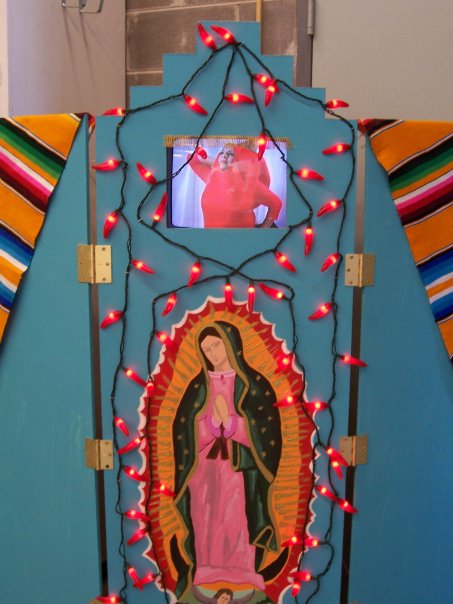 My "Spicy Latina" piece in its full glory. It doesn't get any better than chili pepper lights, Mexican sarape blankets, a traditional Virgin de Guadalupe, and a gold dangly. ay ay ay!!Check out this post Identity Issues Affecting Puerto Rican Girls: An Artist Speaks to hear more on the Spicy Latina.
My "Spicy Latina" piece in its full glory. It doesn't get any better than chili pepper lights, Mexican sarape blankets, a traditional Virgin de Guadalupe, and a gold dangly. ay ay ay!!Check out this post Identity Issues Affecting Puerto Rican Girls: An Artist Speaks to hear more on the Spicy Latina.
I have been told “Oh you just look like you like to have sex” (by both men and women.) I have come to expect this as the norm: being called a spicy latina, hot tamale, firecracker and other such fiery terms. Cofer states that “advertisers have designated “sizzling” and “smoldering” as the adjectives of choice for describing not only the foods but the women of Latin America.”
UPDATE: PHOTOS
 On an almost daily basis, I receive emails from people asking if I am in fact actually Jewish. Although I do find it somewhat bizarre that they find satisfaction in my acknowledgment of what I have already stated numerous times, I usually respond. Come to think of it, the occasions where I have been accepted as a Jew (without further questioning) have been few and far between.
On an almost daily basis, I receive emails from people asking if I am in fact actually Jewish. Although I do find it somewhat bizarre that they find satisfaction in my acknowledgment of what I have already stated numerous times, I usually respond. Come to think of it, the occasions where I have been accepted as a Jew (without further questioning) have been few and far between.
Recently I discovered that without our knowledge, the validity of my own and my brother Gonzalo’s Jewishness has come into question (to the point where documentation has been requested) from people that we are now very close with.Below are some of the examples of comments (not emails, I do not share the content of emails without permission) from youtube:
roundedwhtcollar Am I the only one who thinks this reprobate Turd is NOT in fact a Jew? Rafaelpicc But is her las name jewish? or converted? ReptorY her last name isnt jewish. xruchy you are not jewish i guess... tus videos= cero aporte raquelita40 she's half Jewish/ half Guatemalan.nakedjanet marked as spam i am also suspicious. for one thing, escobar is not a typical Jewish name. For another, Jewish girls are usually a whole lot smarter, and have a whole lot more substance, than this girl has
(from chaptzem blogspot) There is no way she is Jewish- there may be a small chance her family are anusim or something.But what gets even more bizarre is that interspersed with in those comments are horrible anti-semitic statements:
johnnycastle86xx all the jews have to die, stupid jewish puta de mierda. Que mierda que Hitler no mato a tu familia, asi tu no hubieras nacido. muerte a los judios y muerte a israel. mocrostyle3600 AnotherJewish nasty bitchmrrimfire She's an ugly cockroachfilet there's a nice Jewishcrew- club... Its re-open and called Auschwitz. the drinks are on the house!!! but only for jewish people roshanpinto13 i want to put you in a concentration camp bitch if your people want israel so bad why don’t you go there and rid the world from your hideous jewish ways
So in light of my sarcasric sense of humor I entitled this post : Maya Escobar isn’t even Jewish I wonder what will come of that statement... From Judaism 101: Who Is a Jew?
First, traditional Judaism maintains that a person is a Jew if his mother is a Jew, regardless of who his father is. The liberal movements, on the other hand, consider a person to be Jewish if either of his parents was Jewish and the child was raised Jewish. Thus, if the child of a Jewish father and a Christian mother is raised Jewish, the child is a Jew according to the Reform movement, but not according to the Orthodox movement. On the other hand, if the child of a Christian father and a Jewish mother is not raised Jewish, the child is a Jew according to the Orthodox movement, but not according to the Reform movement! The matter becomes even more complicated, because the status of that children's children also comes into question.
In my case my mother is Jewish and my father is not. Yet it is my father that pushed me to go to Hebrew school until I was 16. Rain or shine my parents have been attending Shabbat services at JRC for almost 20 years. I remember being so mad as a child that my friends got to go out on Friday nights, and I was stuck with my family not even allowed to watch TV when we got home from services. Vickie Korey left the nicest comment on my Rabbi Brant Rosen’s blog:
I remember Maya at Friday night services at JRC, sometimes listening intently, sometimes reading, but always being present. When one of the children of our extended spiritual family grows to be such a fine, thoughtful and accomplished young woman we are all proud. Gonzolo and Tina have worked hard to set a strong foundation for Maya and I am so pleased for her and her family.
A few months ago I met with my Rabbi to discuss my (art) work. During our discussion I mentioned to him how my father is feeling really nervous about me having an orthodox wedding where he will not be included in the ceremony. Brant said something to me that really touched my heart. Your father is the essence of what a Jew is, he is a stranger in a strange land. I agree with him whole-heartedly, and if you ask most JRC members I am sure they would agree as well. However that does not change the fact that he is not considered to be Jewish by our neighbors, and even if he converted, to them it would not be halakhic unless he went through orthodox conversion. So who is a Jew? Who determines this?As I stated in a previous post I will be working as the art director this summer for Camp JRF. I am in the process of creating this summer’s curriculum that will be geared towards answering these very questions and challenging notions of Jewish Identity. Below is a very rough sketch of my plan…. (Please let me know if you have any suggestions, or would be interested in contributing any resources) The Changing Face of Jewish Identity: an exploration of self and what it means to be a Jew in our contemporary societyTo introduce the concept of a changing Jewish Identity will discuss the following:
Mediums Mixed media sculpture Art Exhibitions The Jewish Identity Project Too Jewish Challenging Tradition Identities Written Works by Ilan Stavans Achy Obejas Rebecca Walker Campers will produce mixed media sculptures that reflect their perception of what it means to be a JewPre- Activities:
Project Campers working in groups of 3-4 will have the option of creating either abstract or representational mixed media sculptures that to them represent Jewish identity. Prior to the construction of their piece students will need to create a (flexible) proposal that outlines their piece.
If they end up going with more representational sculptures I thought it would be really cool to photograph the sculptures and to place them in various Jewish settings and non-Jewish settings (baseball stadium, temple, Shabbat dinner, work, school....)
In her essay The Myth of the Latina Woman/ Just Met a Girl Named Maria, Judith Ortiz Cofer describes her Puerto Rican upbringing in a strict Catholic home in New Jersey, where she was taught to behave like a proper señorita. Cofer explains that the conflicting messages she received as a child, were those commonly propagated by Puerto Rican mothers. “They encourage their daughters to look and act like women and to dress in clothes that our Anglo friends and their mothers found to mature for our age.”When the mere notion of latinidad equates passion and sexuality to gringos, why is it that Latino men are the first ones to point finger and to call these same women suelta (loose) or facil (easy)? Wouldn’t they understand? Have they not been subjected to the same treatment? Perhaps it is comes down to the way they were raised.In the Latino culture ideas of masculinity and femininity are delineated very early on. Author Evelyn P. Stevens, first introduced this concept know as machismo and marianismo in 1973. Machismo grants supreme authority of the man over the woman. Under this doctrine women, who are considered to be morally and spiritually superior to men are able to endure abuse. They grow up expected to follow the sexual code of marianismo, and are submissive to the man’s authority.Puerto Rican culture places women into one of two categories the virgin or the whore; mujeres de la casa (women of the home) or mujeres de la calle (women of the street). Una mujer de la casa, is expected to be pure, giving and compassionate. While, una mujer de la calle is considered to be sluty, wild, and dangerous.In Honor and the American Dream: Culture and Identity in a Chicano Community, author Ruth Horowitz says the following:The very presence of a woman outside the household implicates them in promiscuity and/or sexual misconduct. Puerto Rican girls learn this good girl/bad girl dichotomy most clearly in the recruitment into reproductive labor… A good girl cooks, cleans, takes care of younger siblings, and helps her parents. In contrast una muchacha de la calle is a transgressive women who has gone beyond patriarchal control whose sexuality is unbounded and therefore dangerous.While in Puerto Rico this January, I had the privilege of meeting the incredibly talented video artist, Tamara Liz Rivera Boria. Tamara and I instantly bonded, finding similarity in the content of our work, and decided that we needed to collaborate.I conducted a short series of interviews with her (documented with the camera from my laptop), where she describes her work as it plays on the screen behind her…[youtube=http://www.youtube.com/watch?v=I2SdDl2zaus] click on above image to view videoInterview with Puerto Rican Artist Tamara Liz Rivera BoriaMaya: Tamara, what can you tell me about muchachas de la calle and muchachas de las casa?Tamara: De la casa and de la calle girls might as well be related. They exchange roles sometimes, de la casa girl wanting to be de la calle, and vice versa.Maya: How has this affected you?Tamara: I was raised in a catholic home, in a catholic school. I can tell you, I have been fucked up. I didn’t want to be told what to do, or what to believe in.How can you tell someone that using a condom is a sin? I had many issues over the years being raised like that. Even though my parents are not Catholic extremists. They were pretty easy going that’s how they could understand me or deal with me. Deep inside it made a mark, no matter how much I tried to live and understand the world. I became insane trying to understand other people lifestyle because indeed I might have been raised inside a bubble. I still am kind of in there, don’t wanting to look at how things really are.Maya: What role does your cultural upbringing play in your work?Tamara: Recently I made a video called él, baño de marîa. In this video I present various symbolism about religion, pecados (sins), sexuality, purity, faith among other things. Mainly because our culture has raised us thinking inside the box, controlling us with Christianity, especially Catholicism. Being pure, waiting till marriage although most don’t do it, is deep inside the mind. Like it is wrong to embrace sexuality.Aglubium, is another video I made in collaboration with Ralph Vazquez and Rebecca Adorno. In this video I am drowning, or trying to kill myself by submerging my head in the water. It’s aggressive, and it’s beautiful. We just want to end, we don’t want to think. We don’t want to face fears. We don’t want to wait, we want to get it over. We want to drown our fears. We don’t want to face reality. Escape its what we do.Maya: How do you escape?Tamara: Most people (Puerto Ricans) use drugs. Puerto Ricans that do not use illegal drugs, use legal pills, alcohol or even coffee. Everyone has an addiction. It’s a shame but I have seen most of my friends doing drugs. I been there, I done that but I never had an addiction. My new boyfriend said I was an alcoholic, he didn’t believe me when I said I wasn’t. It wasn’t till he lived with me for over a moth when he saw that I didn’t drink for so long that he believed me, and with the cigarettes the same.For some weird reason I can try things for as long as I want and not create any addiction. I wish it were the same with those that surround me. But in the arts almost all the people I know use some kind of drugs, are the ones that worry me the most are the most intelligent that keep using. I guess they are not that smart…Maya: Is there an alternative to escape?Tamara: I can see clearly that with true art I can make a difference, I can say what I understand to be real and important. I might help somebody. Other people just ignore what is going on (Puerto Rico). So many things had happen here, that demanded the people marching up the streets in protest, because our government is insane. But people don’t, they just “sit quietly”. They don’t want to get involved, they think they cannot change anything. They believe they have no power, when indeed I say, with all your power, what would you do? – I love that flaming lips song-Maya: How does this affect Puerto Rican girls?Tamara: Puerto Rican girls have many issues. Not only because of gringos (Americans) our identity issues extend into religion and the ways women are portrayed in the reggaeton culture. Girls want to be thin like gringas (American girls), they don’t like they’re beautiful curves, ass and tits. They always feel fat no matter how thin they are. I bet this happen everywhere, but these are issues we shouldn’t have.Accepting ourselves, as we are its what we should do. Because we are not gringas! We are not blonde and white! But boys see these girls in TV, and everywhere and they expect girls like that. It’s the gringo media. I’ve forgotten all about this, but I also had these issues. I think I kind of still do, I just ignore most of the time.Maya: You mentioned Reggaeton, what message do you think Reggaeton is sending to young women?Tamara: Reggaeton is a part of that movement leads ladies to feeling less than the man, like he has to buy her. Girls learn to use their sexual power way to early with reggaeton. It is a confrontation for some, between what they like (reggaeton movement, lifestyle) and the religious foundation they might have. But since it probably was forced (religion) they escaped thru reggaeton. Ultimately ending in ugly situations.Maya: Okay , I agree with you. But I am not going to lie, I love reggaeton… are you sure you don’t secretly like it?Tamara: I don’t dig reggaeton; I see how girls embrace being just a piece of meat, especially high schools girls. How much is this necklace, like a million? Said a girl, the boy answered – no. The girl said - well then, work and buy me this necklace.Yesterday I heard a senior girl say that to her boyfriend at a hotel, it was their prom. Girls parade in lil’ dresses, easily they could have been mistaken for high-class whores. I won’t even comment on the dancing. It has gotten worse, every time. Since parents are so young they allow they’re children to behave like this. I mean, I see a problem with these situations. Boys catch another boy,looking at their girls, no matter if its sexual or if they just passed and look because its simply there, they get all worked up and want to fight. What is that dumbass looking at? So basically, what, people cant look at each other now? Girls can’t stand if you look at them either. Puerto Rico was not like that; you went to the mall, smiled and people smiled back at you.The reggaeton anger and sexual damage can be easily identified. Even kindergarten boys are sexually harassing little girls. My mom is a teacher and I have heard some stories. I haven’t analyzed reggaeton issues deeply; this is just for what I have seen.Maya: Thank you for your insight Tamara, I can’t wait to see what you produce next. I hope we can collaborate together in the future.Tamara: I know I could make more sense out of my ideas, since they’re not organized very well, but it doesn’t matter. This is just the beginning of many wonderful works to come, ideas to flow… I’m glad that I can collaborate with you.
click on above image to view videoInterview with Puerto Rican Artist Tamara Liz Rivera BoriaMaya: Tamara, what can you tell me about muchachas de la calle and muchachas de las casa?Tamara: De la casa and de la calle girls might as well be related. They exchange roles sometimes, de la casa girl wanting to be de la calle, and vice versa.Maya: How has this affected you?Tamara: I was raised in a catholic home, in a catholic school. I can tell you, I have been fucked up. I didn’t want to be told what to do, or what to believe in.How can you tell someone that using a condom is a sin? I had many issues over the years being raised like that. Even though my parents are not Catholic extremists. They were pretty easy going that’s how they could understand me or deal with me. Deep inside it made a mark, no matter how much I tried to live and understand the world. I became insane trying to understand other people lifestyle because indeed I might have been raised inside a bubble. I still am kind of in there, don’t wanting to look at how things really are.Maya: What role does your cultural upbringing play in your work?Tamara: Recently I made a video called él, baño de marîa. In this video I present various symbolism about religion, pecados (sins), sexuality, purity, faith among other things. Mainly because our culture has raised us thinking inside the box, controlling us with Christianity, especially Catholicism. Being pure, waiting till marriage although most don’t do it, is deep inside the mind. Like it is wrong to embrace sexuality.Aglubium, is another video I made in collaboration with Ralph Vazquez and Rebecca Adorno. In this video I am drowning, or trying to kill myself by submerging my head in the water. It’s aggressive, and it’s beautiful. We just want to end, we don’t want to think. We don’t want to face fears. We don’t want to wait, we want to get it over. We want to drown our fears. We don’t want to face reality. Escape its what we do.Maya: How do you escape?Tamara: Most people (Puerto Ricans) use drugs. Puerto Ricans that do not use illegal drugs, use legal pills, alcohol or even coffee. Everyone has an addiction. It’s a shame but I have seen most of my friends doing drugs. I been there, I done that but I never had an addiction. My new boyfriend said I was an alcoholic, he didn’t believe me when I said I wasn’t. It wasn’t till he lived with me for over a moth when he saw that I didn’t drink for so long that he believed me, and with the cigarettes the same.For some weird reason I can try things for as long as I want and not create any addiction. I wish it were the same with those that surround me. But in the arts almost all the people I know use some kind of drugs, are the ones that worry me the most are the most intelligent that keep using. I guess they are not that smart…Maya: Is there an alternative to escape?Tamara: I can see clearly that with true art I can make a difference, I can say what I understand to be real and important. I might help somebody. Other people just ignore what is going on (Puerto Rico). So many things had happen here, that demanded the people marching up the streets in protest, because our government is insane. But people don’t, they just “sit quietly”. They don’t want to get involved, they think they cannot change anything. They believe they have no power, when indeed I say, with all your power, what would you do? – I love that flaming lips song-Maya: How does this affect Puerto Rican girls?Tamara: Puerto Rican girls have many issues. Not only because of gringos (Americans) our identity issues extend into religion and the ways women are portrayed in the reggaeton culture. Girls want to be thin like gringas (American girls), they don’t like they’re beautiful curves, ass and tits. They always feel fat no matter how thin they are. I bet this happen everywhere, but these are issues we shouldn’t have.Accepting ourselves, as we are its what we should do. Because we are not gringas! We are not blonde and white! But boys see these girls in TV, and everywhere and they expect girls like that. It’s the gringo media. I’ve forgotten all about this, but I also had these issues. I think I kind of still do, I just ignore most of the time.Maya: You mentioned Reggaeton, what message do you think Reggaeton is sending to young women?Tamara: Reggaeton is a part of that movement leads ladies to feeling less than the man, like he has to buy her. Girls learn to use their sexual power way to early with reggaeton. It is a confrontation for some, between what they like (reggaeton movement, lifestyle) and the religious foundation they might have. But since it probably was forced (religion) they escaped thru reggaeton. Ultimately ending in ugly situations.Maya: Okay , I agree with you. But I am not going to lie, I love reggaeton… are you sure you don’t secretly like it?Tamara: I don’t dig reggaeton; I see how girls embrace being just a piece of meat, especially high schools girls. How much is this necklace, like a million? Said a girl, the boy answered – no. The girl said - well then, work and buy me this necklace.Yesterday I heard a senior girl say that to her boyfriend at a hotel, it was their prom. Girls parade in lil’ dresses, easily they could have been mistaken for high-class whores. I won’t even comment on the dancing. It has gotten worse, every time. Since parents are so young they allow they’re children to behave like this. I mean, I see a problem with these situations. Boys catch another boy,looking at their girls, no matter if its sexual or if they just passed and look because its simply there, they get all worked up and want to fight. What is that dumbass looking at? So basically, what, people cant look at each other now? Girls can’t stand if you look at them either. Puerto Rico was not like that; you went to the mall, smiled and people smiled back at you.The reggaeton anger and sexual damage can be easily identified. Even kindergarten boys are sexually harassing little girls. My mom is a teacher and I have heard some stories. I haven’t analyzed reggaeton issues deeply; this is just for what I have seen.Maya: Thank you for your insight Tamara, I can’t wait to see what you produce next. I hope we can collaborate together in the future.Tamara: I know I could make more sense out of my ideas, since they’re not organized very well, but it doesn’t matter. This is just the beginning of many wonderful works to come, ideas to flow… I’m glad that I can collaborate with you.
“Everything that surrounds me, mi entorno, makes a part of who I am and what I say in my videos. Little by little its somehow implicated.”
As I begrudgingly stated in my interview with Tamara, I am a fan of reggaeton. Like most, I don’t even acknowledge the lyrics or really think too much beyond the beat of the music. Yet now I find myself wondering, are most girls conscious of the message? I guess to some extent they must be, after all as Tamara shared many sing the lyrics as they grind (rub up) on men.In my research I found extensive commentary regarding the direction of Salsa and its implications on women in the Puerto Rican community. However, as it is relatively new form of music, the writing concerning Reggaeton seems to be incredibly limited.So I turned to a more contemporary source and found a blog entitled REGGAETONICA, written by Raquel Z. Rivera; author of New York Ricans from the Hip Hop Zone. In a recent post: From White to Mulata: The Darkening Powers of Reggaetón, she shares an email addressing this very issue:
I think reggaeton has been raunchy & explicitly all along, but I think the lyrics have reverted back to the "Reggeaton Sex" days of Underground. I think that "raunchiness" & degradation have become more mainstream & therefore are seen as less scandalous & more acceptable to society, so I think it has questioned our value as a community. The fact that Reggaeton outright refers to sexual references & acts & is accepted as mainstream Puerto Rican culture posing an interesting cultural issue for me. Now you can go to Puerto Rico and see young girls singing "dame con el palo, " & they're parents paying no mind to it, which I think is crazy. In the beginning of Reggaeton I found the lyrics to be much more raunchy, violent, & drug-related. Then mainstream Reggaeton came along, switched the "sexo" to "amor" & the "nenas" to "gatas." I think these subtle changes in language allowed Reggaeton to be more successful in the mainstream, but now a lot of artists are moving back to the original lyrics because they already have a stable fan base. I mean, look at someone like Tony Dize, if you translated some of his songs into English, they could put even 50 Cent to shame with the blatant sexual references & degradation of women.
Perhaps reggaeton is so widely accepted by mainstream and popular culture, because it provides a free ticket to promote these concepts in a non-threatening form. If Puerto Rican women and other Latinas are fine dancing to this music, then what harm is there in gringos doing the same.This then becomes representative of Puerto Rican culture. When a gringa dances to reggaeton she can purse her lips and grind on men, but without an attached stigma. She is just acting like a Latina girl. The Puerto Rican girls participating in this scene are aiding in the further perpetuation of the stereotype of Latina’s being easy.However, as Tamara explained a lot of this has to do with a search for independence. Wanting to rebel against the forced restrictions of being una mucha de la casa, girls go to the furthest extreme to break down those barriers. But to what cost?I myself am unable to provide a concrete solution. Yet I do think that one of the primary steps to forward progress is conversation. Tamara and myself have opted to publish the text on the web so that others may join in the dialog…[youtube=http://www.youtube.com/watch?v=rxiWzxItuzo]
So here I am introducing the best of the best...They will make you laugh, think, laugh some more and then go do somethingRicardo from U N L O A D E D Ricardo is a Puerto Rican Jewish Playright. The first time I cam across his blog U N L O A D E D Ricardo had a post thanking a friend for describing him as a sexy Puerto Rican blooded beast .link to his screenplays
Ricardo is a Puerto Rican Jewish Playright. The first time I cam across his blog U N L O A D E D Ricardo had a post thanking a friend for describing him as a sexy Puerto Rican blooded beast .link to his screenplays
in another email
I came very close once to putting my picture up on Jdate but couldn't do it. I could definitely see lots of guys, intoxicated by by the likes of Selma and Penelope or J-Lo, wanting to bring you home for a one night stand and brag to their friends about how they "took a dip in some salsa." We men are terrible in this regard but I can imagine it would be very frustrating for you. You ought to be appreciated for what you've done artistically, academically and politically because those things are what create the whole person so to speak. But I bet these men wanted to hear none of that and just wanted you to talk dirty to them in Spanish, again we men are awful but in my opinion these men are also very insecure. Why? Because they lack the social skills to get past the stereotypes and engage you for who you are. If they really wanted to know more about the Latin culture there are tons of better approaches that are not so lame like "muy picante." I mean really, I would not say that seriously no matter how drunk I was. Just talk to people as equals.Now as far as respect from the others in the Latin community, cherish it. Often times there is resentment if you are accomplished. While you are loved, I am usually hated. First off people can't always place my ethnicity. I get everything in the book before they get to Puerto Rican. Yeah I don't have an accent, so what? I don't speak it but my family came here in the 20's, what do you expect? Things fade. I do understand it however so if someone's talking smack about me, I know. Artistically, hated by some in my family because I don't write or perform about racial issues. If I'm compelled to do so and it feels right, then I will. I'm not close with them anyway so it doesn't mater.I have no shame in who I am but if I'm expected to act a certain way for the appeasement of the ethnic police, then arrest me because I am who I am and feel no need to apologize for it.Now if women wanted to use me for a latin sex toy...Maya...I'll be honest, I'll be her Toys R Us if she's she's got the stuff. But men don't really get used this way. Not in America at least. Europe would be a different story. But even that would grow old in time I suppose, a very long time but still ;-)
Daniel aka theMULatino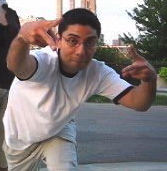 Daniel is a Mexican American Graduate Student at Missouri University. Daniel is the self-proclaimed token minority at MU.from his blog
Daniel is a Mexican American Graduate Student at Missouri University. Daniel is the self-proclaimed token minority at MU.from his blog
This video was my first introduction to theMULatino.[youtube=http://www.youtube.com/watch?v=y0a4dJGRD9g]after seeing that hilarious video and reading his blog I had no choice but to post a response video.[youtube=http://www.youtube.com/watch?v=ENqJhrW0opI]To get the ball rolling I asked them to answer the following questions:
Intellectuals, Comedians, Artists



 [youtube=http://www.youtube.com/watch?v=b1ETIAoRbm4] [youtube=http://www.youtube.com/watch?v=1mu_a69i1G0][youtube=http://www.youtube.com/watch?v=7ZOp8BKaccs]
[youtube=http://www.youtube.com/watch?v=b1ETIAoRbm4] [youtube=http://www.youtube.com/watch?v=1mu_a69i1G0][youtube=http://www.youtube.com/watch?v=7ZOp8BKaccs]Daniel's Responses:
please feel free to share your responses

obsessed with frida kahlo, 2007
[youtube=http://www.youtube.com/watch?v=rxqo7aJtD0U]
el es frida kahlo, 2007
[youtube=http://www.youtube.com/watch?v=xlMPoFXRT18]
part of the piece I did for d[x]i magazine on the commodification of Frida Kahlo
auto retrato, 2003
frida painting, 2007
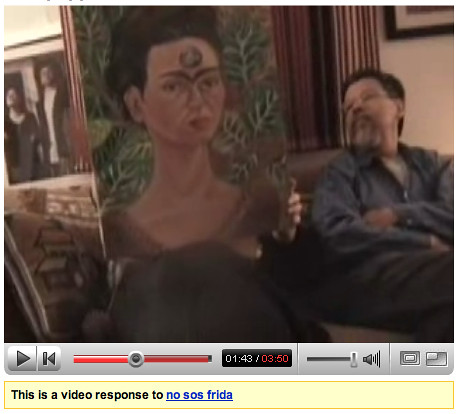
frida puppets, 2007
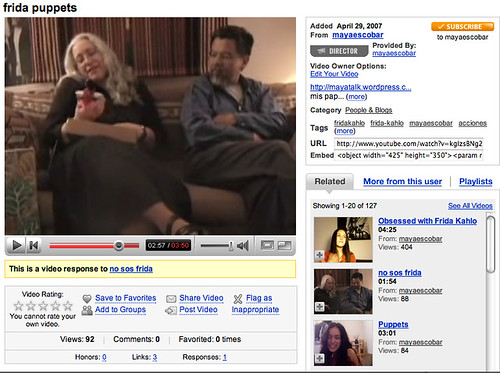
[youtube=http://www.youtube.com/watch?v=QzqBX0HoPSo]
In search of the #1 Frida Kahlo fan in the World

PROVE IT answer the following questions:
When did you fall in love with Frida?
Why do you admire her?
What trivia do you know about Frida Kahlo?
How many and what Frida objects do you own? (prints of her work, t-shirts, mugs, wall hangings, toothbrushes, etc...)





please leave a written comment, submit photos, or a video responseDressed as Frida
RELATED POSTSGallery OpeningNext Phase of Acciones PlasticasVideo ResponsesHow does it feel to be called a JAP? Now I am asking you to participate. Hopefully viewing these images has caused you to question if and when similar stereotypes have been applied to you or those around you. Please take the time to share your experiences by clicking on any of the dolls to submit your response.



 I have included a section with guiding questions. If you have more you would like to submit post them herePlease feel free but not limited to answering the following questions regarding each doll:
I have included a section with guiding questions. If you have more you would like to submit post them herePlease feel free but not limited to answering the following questions regarding each doll:
Is there any truth to this description?Are all of these things negative?What is the origin of this stereotype?What is a _________ really like?What does this stereotype leave unsaid?
[youtube=http://www.youtube.com/watch?v=wBkROAn7efM][youtube=http://www.youtube.com/watch?v=-kohK1qimhI][youtube=http://www.youtube.com/watch?v=4Zsr4NmtG0I]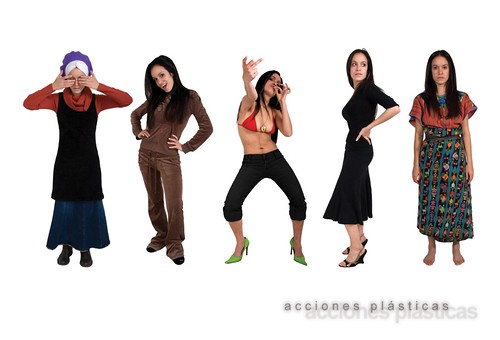
UPDATEBraulio was featured on artnet.com Artist Alfi Rolón performing as part of Braulio Espinosa Castillo’s "Artistas de Hoy"
Artist Alfi Rolón performing as part of Braulio Espinosa Castillo’s "Artistas de Hoy"
Circa ’07 also featured a row of smaller booths housing individual projects by invited artists. One of the most popular was "Artistas de Hoy," a project stage-managed by Braulio Espinosa Castillo of Producto? Inc., for which he somehow convinced 40 artists to pose in a glass display case alongside a video of their artwork. The combination was a perfect gambit. Not only were the videos illuminating, but fair visitors clearly were enchanted by the opportunity to stare at real artists standing in a booth.
Producto? Inc. es una propuesta que nace de la reflexión en torno a la condición "natural" del individuo como producto mercantil. Con la dirección de Braulio Espinosa Castillo y la colaboración incondicional de familiares, amigos, colegas artistas y auspiciadores.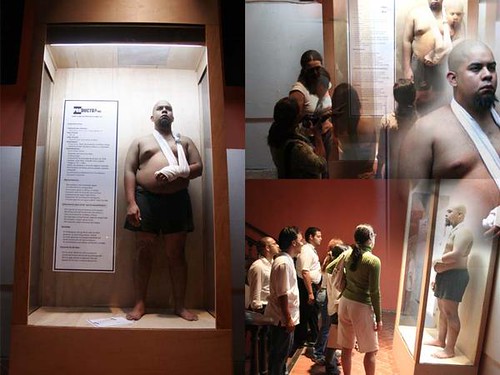
El proceso de cosificación que produce la sociedad de consumo a la que nos enfrentamos a diario no se limita solo a la materia no viviente y no pensante, sino también a los seres humanos: mercaderes y consumidores. Siempre el hombre ha puesto algún tipo de valor sobre la materia, sea viva o no. Un producto mercantil es una cosa producida con la finalidad de la venta. En el contexto actual de vida somos un producto mercantil, primero por que somos una cosa producida. Producida por el hogar, la iglesia, las escuelas, la universidad, los trabajos. Segundo, mientras no exista otro sistema económico, todos cambiaremos dinero por nuestro servicio; trabajo y conocimiento. El salario mide el precio del trabajo, que a fin de cuenta, define el valor material del trabajador, el producto. En algunos países el acto es aún más literal, cuando se venden esclavos, niños y órganos humanos.
En CIRCA 07 estarán participando 40 colegas artistas, cada uno con su propuesta individual de ellos mismos como producto mercantil. Durante 25 minutos estarán en exhibición, en instalación-performace.
 Please take this as an opportunity to let your voice be heard. I welcome anyone who would like to offer a response online, either written or in the form of a video blog. Remember that the acciones plásticas videos are not the stereotypes themselves, they are women who have be affected by their presence.I will continuously update this post with videos as they are submitted. "How does it feel to be called a _____?" Feel free, (but not limited) to respond to the stereotypes I have presented. Use this as an opportunity to share your own experiences.If you are an educator takes this as an opportunity to discuss these issues with your students. I am in the process of developing curriculum for presenting acciones plásticas in the classroom.
Please take this as an opportunity to let your voice be heard. I welcome anyone who would like to offer a response online, either written or in the form of a video blog. Remember that the acciones plásticas videos are not the stereotypes themselves, they are women who have be affected by their presence.I will continuously update this post with videos as they are submitted. "How does it feel to be called a _____?" Feel free, (but not limited) to respond to the stereotypes I have presented. Use this as an opportunity to share your own experiences.If you are an educator takes this as an opportunity to discuss these issues with your students. I am in the process of developing curriculum for presenting acciones plásticas in the classroom.

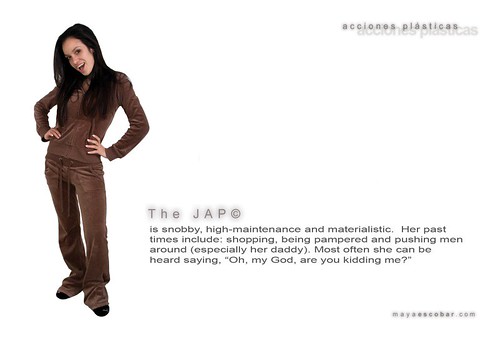
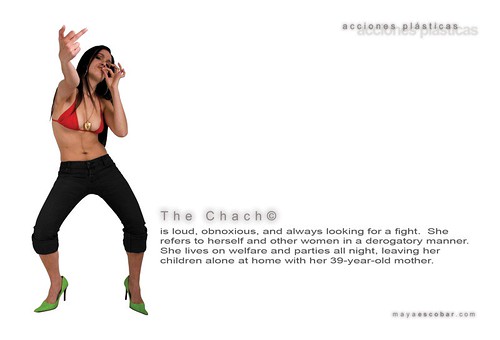
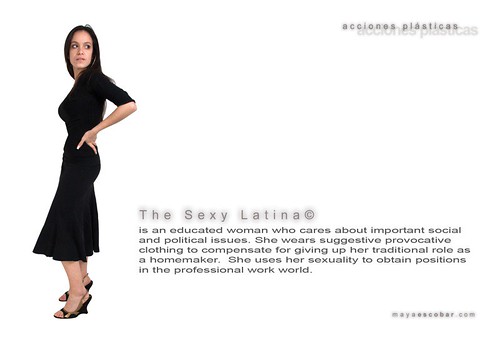
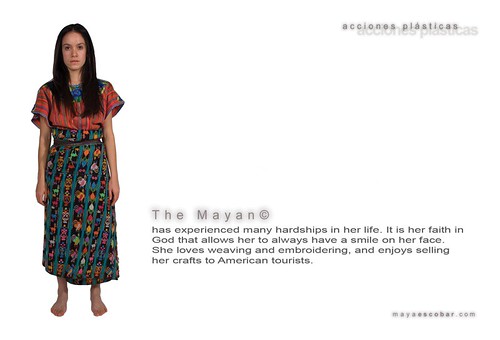
while the "youtube" video blogs are played on a reel.


 The public will be invited to respond, by altering the text accompanying each doll. Over the course of the exhibition the original cards displaying the stereotype will be replaced by the new cards with altered text.Your video responses will be incorporated into the reel. From the show Now I am asking you to participate. Hopefully viewing these images has caused you to question if and when similar stereotypes have been applied to you or those around you. Please take the time to share your experiences by clicking on any of the dolls to submit your response.
The public will be invited to respond, by altering the text accompanying each doll. Over the course of the exhibition the original cards displaying the stereotype will be replaced by the new cards with altered text.Your video responses will be incorporated into the reel. From the show Now I am asking you to participate. Hopefully viewing these images has caused you to question if and when similar stereotypes have been applied to you or those around you. Please take the time to share your experiences by clicking on any of the dolls to submit your response.



 I have included a section with guiding questions. If you have more you would like to submit post them herePlease feel free but not limited to answering the following questions regarding each doll:
I have included a section with guiding questions. If you have more you would like to submit post them herePlease feel free but not limited to answering the following questions regarding each doll:
Is there any truth to this description?Are all of these things negative?What is the origin of this stereotype?What is a _________ really like?What does this stereotype leave unsaid?
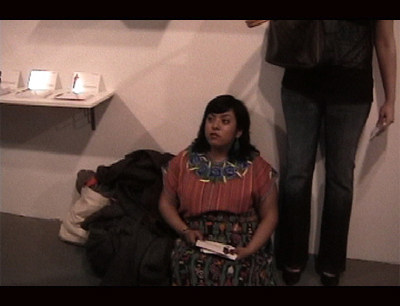 [youtube=http://www.youtube.com/watch?v=-kohK1qimhI][youtube=http://www.youtube.com/watch?v=4Zsr4NmtG0I]
[youtube=http://www.youtube.com/watch?v=-kohK1qimhI][youtube=http://www.youtube.com/watch?v=4Zsr4NmtG0I]
